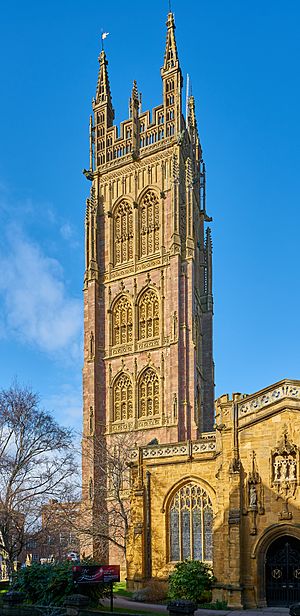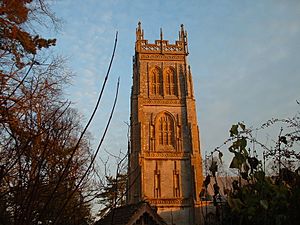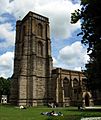Somerset towers facts for kids

The Somerset towers are a special group of tall, beautiful church towers found in the county of Somerset in southwest England. Most of these towers do not have a pointy top (called a spire). They were built in a style called Gothic, which was popular a long time ago.
Contents
What Makes Somerset Towers Special?
Many people, like writer Simon Jenkins, believe these towers are some of the best examples of medieval art in England. They are known for their unique style, detailed decorations, and impressive height. They stand out across the flat lands of Somerset.
One writer said: "Somerset has about 90 amazing medieval towers. Fifty of these are truly great designs. This makes the county very special in the history of English art." These towers were often paid for by the rich wool trade in the 1400s. It's amazing that such grand buildings were built even in small villages!
How They Were Built
Many Somerset towers were built on the foundations of older Norman churches. They were made in the Perpendicular Gothic style, which means they have lots of straight, tall lines. These square towers usually stand on the west side of the churches and have strong corner supports called buttresses.
Some towers are very tall, over 100 feet (30 m) high! The north tower of Wells Cathedral, built around 1440, is a huge 182 feet (55 m) tall. Most of these towers hold bells, and bell-ringing is a tradition that continues in some churches today.
Many of these churches are considered very important buildings. They are called "Grade I listed buildings" by English Heritage. This means they are of great national importance for their history or design. Some are "Grade II* listed," meaning they are very significant locally.
Building these towers was a big job. Sometimes, a master builder and a small team of skilled masons traveled around, helped by local workers. Other experts think famous architects designed the towers, taking ideas from grand cathedrals. Then, local builders would carry out the plans, adding their own unique touches. It's truly amazing how much money and skill went into building so many churches in a short time. The towers often received the most detailed and beautiful work.
Cool Features of the Towers
The designs of the Somerset towers were inspired by big churches like Gloucester Cathedral, Wells Cathedral, and Glastonbury Abbey. But the builders also came up with new ideas and borrowed designs from each other. They added more levels and fancy decorations whenever there was enough money. The building of these towers mostly stopped around the 1500s because of a big change called the Reformation.
The towers are special because of their beautiful details. Look for:
- Pinnacles: Small, pointed towers on the roof.
- Tracery: Lacy stone patterns in windows and bell openings.
- Gargoyles: Carved stone figures, often shaped like monsters, that act as water spouts.
- Parapets: Low walls at the edge of the roof.
- Merlons: The solid parts of a castle-like wall, often seen on parapets.
- Turrets: Tall, thin towers with stairs inside.
These decorations were often made from soft, colorful limestone found in Somerset. This stone, like Bath stone or Hamstone, is easy to cut into fancy shapes. However, because it's soft, it can wear away over time due to weather. For the main walls and foundations, builders often used blue lias, another local stone, or other stones from nearby quarries like red sandstone. They usually used the stone that was easiest and cheapest to transport.
Learning About the Towers
It's hard to know exactly when and by whom these old towers were built because there are not many records left. But for over a hundred years, experts have studied them. They try to group the towers and figure out their ages.
Early experts like Edward Augustus Freeman and Dr. F.J. Allen tried to classify the towers based on their age and how their windows were arranged. Later, in 1981, a researcher named Poyntz Wright used early computer analysis to look for patterns. He studied details like the number of windows, the decorations on the pinnacles, and the style of the buttresses. He suggested different "generations" of towers, like "The Churchill Generation," which included churches with smaller towers and single windows.
However, another expert, John H. Harvey, disagreed with some of these ideas in 1984. He thought that the main arch inside the tower was a better clue to its age because it was harder to change later. He believed that the southwest tower of Wells Cathedral, designed by William Wynford, was the inspiration for the typical "Somerset Tower" style. This style then spread to other churches nearby, like St. Cuthbert's parish church in Wells.
Today, experts still wish for a big team of historians and architects to study all the clues and create a final, clear timeline for these amazing towers. Until then, the exact dates and groupings are still being discussed!
See also
- List of Somerset towers
- Towers in Somerset
- English Gothic architecture




